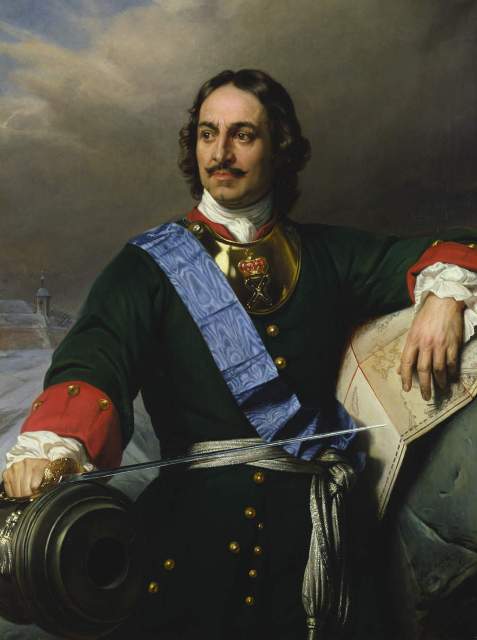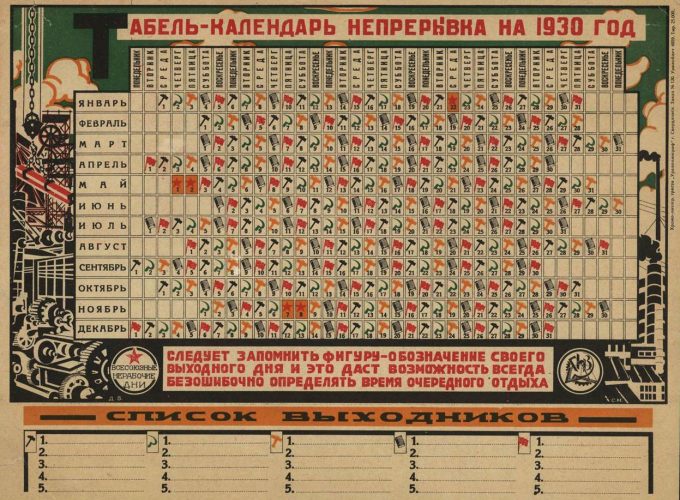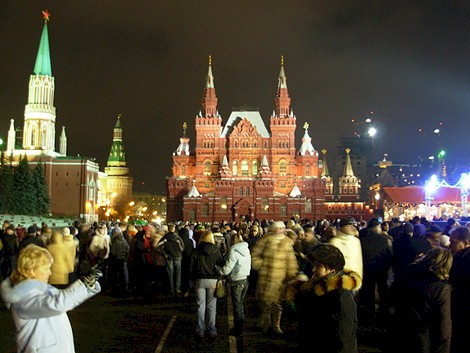Calendar issues
English > Context > Social > Calendar issues
Throughout this site you can find some dates mentioned in a rather peculiar way. Like May 3 [15], 1891 for Bulgakov's birthday, for instance. It doesn't mean that I'm not sure whether he was born on May 3 or May 15. No, it has to do with the different calendar systems that were used. Bulgakov was born on May 3, 1891 following the Gregorian calendar, which was May 15, 1891 following the Julian calendar.
Up to the end of the fifteenth century the Russian year began on March 1. Years were counted from the creation of the world, an event that was situated in the year 5509 B.C. In the year 7208 of this calendar system - our year 1699 - czar Peter I Alekseevich (1672-1725) or Peter the Great introduced the Julian calendar and decided that the next January 1 would be January 1, 1700. A quite unusual decision, since many other countries were using the Gregorian calendar since 1582. Therefor they had skipped 10 days.
In 1918, after the Revolution, Lenin raised the question of calendar reform and, after an investigation of the subject, published a decree directing the adoption of the Gregorian style «for the purpose of being in harmony with all the civilized countries of the world.» But the Whites continued to follow the Julian calendar, so your birthday could differ depending on who was in power of which territory on that day.
The adoption of the Gregorian calendar necessitated a cancellation of 13 days, instead of ten days like when the other countries introduced the Gregorian calendar because, in the interval, three centurial years had been counted as leap years.
The Eternal Calendar
In 1929 a radical change in the era had to take place. On August 26, the Council of People's Commissars of the Soviet Union issued a decree to abolish both the official Gregorian calendar - installed by Lenin - and the Julian calendar - which was still used by the Russian Orthodox Church. They wanted to introduce a new calendar, in which the weeks were changed and the earlier religious holidays were replaced by days off related to the Revolution.
This Советский революционный календарь [Sovietsky revolyutsionny kalendar] or Soviet revolutionary calendar,commonly referred to as the Eternal Calendar, had to be effective on October 1, 1929. A week had five days and there were six weeks in a month, leaving 12 months of 30 days, or 72 weeks of 5 days, plus five holidays that had a revolutionary name, not the name of a normal weekday. The main purpose of the Eternal calendar was to increase productivity because the rest days were spread out. The workers were divided into five groups, indicated by a color (yellow, pink, red, purple, green), and each group had its own rest day, without taking into account that this could cause problems for family life. But productivity would also seem to suffer because the machines were running continuously, so there was no time to properly maintain them. A bizarre side effect was also the fact that the Soviet Union would have been the only country with 30 days in February.
But the Russians once again showed that they had great adaptability. Just as they continued to count in rubles when the chervonets was the official currency in the Soviet Union, they used the Eternal calendar only to schedule their working days, and they continued to follow the old calendar in their daily lives.
Anyway, in 1931, the fuzz was already over. The revolutionary calendar turned out not to be eternal. The five-day week and staggered rest-days were replaced by another system. This new plan provided for a 12-month year with the same holidays as before and the same extra day for leap years, but a new week of six days was introduced wherein the rest-day came regularly on the 6th, 12th, 18th, 24th and 30th of the month.
From 1940 onward, the Soviet Union returned to the Gregorian calendar with its seven-day week, using Sunday as a rest-day. By this latest action the government returned to the idea of Lenin, and Russia is again using the same calendar as «all the civilized countries of the world».
Christmas and Old New Year
Although the government officially accepted the Gregorian calendar, the Russian Orthodox Church still clung to the earlier and more familiar Julian calendar, and they even do so still today. This is the reason, for example, why they don't celebrate Christmas on December 25, like in the Gregorian calendar, bot on January 7, in line with the Julian calendar. And New Year is on January 14. For many Russians it is, still today, used as a reason to celebrate New Year twice: the normal New Year on January 1, and the Старый Новый год [Stary Novy god] or Old New Year on January 14.
Easter
The Master and Margarita is situated in the days before Easter. The bible story of Pilate and Yeshua is in the days of the feast of Pesach, the Jewish spring feast.
In the first centuries after Christ, almost all local churches celebrated Easter on a different date. Some churches determined the date in function of the Jewish Pesach, while others celebrated Easter on every March 27, and there were many more traditions, each with another result.
In 325, the first Oecumenical Council in Nicaea made an end to this. An Oecumenical Council is a general council of Christian bishops from the entire church. The aim was to use one rule to calculate the date of the celebration of the Resurrection of Christ.
The Council decided that the celebration of the Resurrection should always be after the Jewish Pesach, for the Resurrection itself had been after Pesach. In addition, it had to be a Sunday, so a fixed date could not be considered. The Council decided that the feast should be on the first Sunday after the first full moon after the first day of spring or the spring equinox. The date of Pesach was calculated in a similar way, so this calculation should be sufficient to have Easter always after Pesach. For the years in which this would not work, the Council added «after the Jewish Pesach».
Easter Sunday is in the middle of the annual easter cycle and determines the date of the other christian feastdays in this cycle. Ash Wednesday, first day of the Lent, is always 46 days before Easter (there are fourty fast days, the Sundays in this cycle are not counted), Ascension is always fourty days after Easter, Whitsuntide or Pentecost is always on the 7th Sunday or the 50th day after Easter. Fifty in Greek is πενήκοντα [penikonta], of which the word Pentecost is derived.
After 1582, the year in which Rome introduced the Gregorian calendar, the Orthodox Church continued using the Julian calendar, and the date of Easter is still calculated according to it. A long time ago, the Orthodox Church has considered to reform the calculation, but they did not want to introduce a method by which Easter could fall before Pesach.
In the Julian calendar, March 21 is always 13 days later compared to the Gregorian calendar. So the first full moon after it is not the same neither. It can coincide, but it can differ up to more than a month (after the next full moon).
Share this page |





